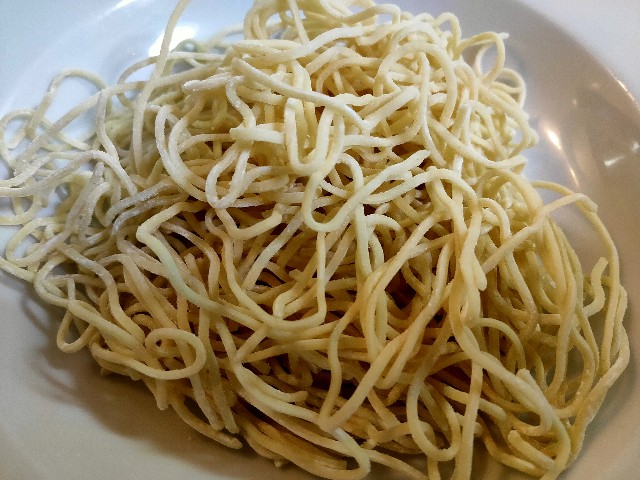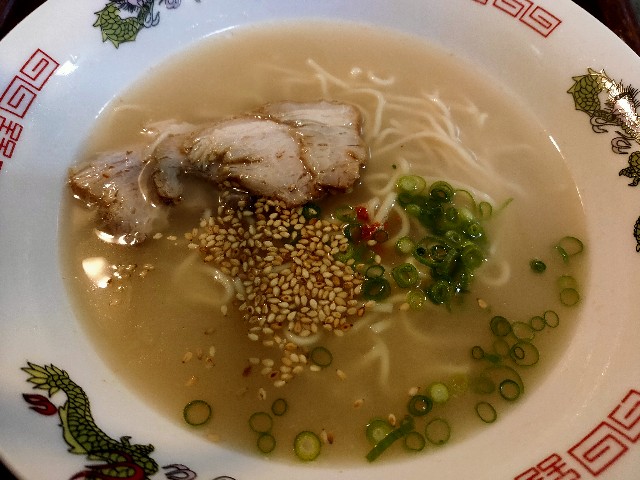After simmering the pork bones for about 10 hours, the soup is ready. Add 1.5 to 2 tablespoons of the sauce we made last time to a ramen bowl, and dilute it with 300cc of soup to make ramen soup.

Put the noodles, which have been boiled to be firm, into this soup. I think thin Hakata-style noodles are good, but medium-thick noodles are also fine.

Season to taste with pepper, chili oil, and char siu sauce, etc. Top with your favorite ingredients like char siu to complete the ramen.



I made ramen for the first time in a while, and it was surprisingly delicious. The soup is very smooth and full of umami, but it doesn't have any unpleasant smell. The careful preparation might have been good. I'm likely to make it frequently from now on.

Click the link below to view the Japanese version of the article
博多ラーメン (Hakata Ramen): A type of ramen from Hakata, a district of Fukuoka city in Japan. It is known for its rich, milky, pork-bone tonkotsu broth and thin, non-curly and resilient noodles.
とんこつラーメン (Tonkotsu Ramen): A ramen dish that originated in Fukuoka, on the Kyushu island of Japan. It has a base soup made from pork bones and other ingredients, which is typically boiled for several hours.
自作 (Jisaku): Means "self-made" or "homemade". It refers to something that is made by oneself rather than bought from a store.
合計 (Goukei): Means "total" or "sum". It is used to indicate the total amount of something.
煮込む (Nikomu): A cooking method that involves simmering or stewing ingredients over a long period.
スープ (Soup): Borrowed from English, it refers to a liquid dish, often made by boiling meat, fish, or vegetables, etc., in water or stock.
前回 (Zenkai): Means "last time" or "previous". It is used to refer to the previous instance or occurrence of something.
タレ (Tare): A general term for dipping sauces often used in Japanese cuisine. In the context of ramen, it's the base flavoring mixed into the soup.
ラーメン丼 (Ramen Don): A bowl specifically designed for serving ramen. It is usually larger than regular bowls to accommodate the noodles, soup, and various toppings.
大さじ (Oosaji): A unit of measurement in Japanese cooking, equivalent to a tablespoon.
程度 (Teido): Means "degree" or "extent". It is used to indicate the level or amount of something.
茹でる (Yuderu): A cooking method that involves boiling food in water.
麺 (Men): Means "noodles". In the context of ramen, it refers to the long, thin, wheat-based noodles.
博多風 (Hakata-fuu): Means "in the style of Hakata". It refers to something that is done in the manner or style of Hakata.
細麺 (Hosomen): Thin noodles, often used in Hakata-style ramen.
中太麺 (Chuutamen): Medium-thick noodles, a type of noodle that is thicker than thin noodles but thinner than thick noodles.
好み (Konomi): Means "preference" or "taste". It is used to indicate one's personal preference or liking.
胡椒 (Kosho): Pepper. A spice that is commonly used in cooking for its hot and pungent flavor.
ラー油 (Rayu): Chili oil. A condiment made from vegetable oil that has been infused with chili peppers.
チャーシュー (Chashu): A dish made of marinated, braised pork belly rolled into a log and sliced thinly. It's a common topping for ramen.
タレ (Tare): In the context of chashu, it refers to the sauce in which the pork is marinated and cooked.
具 (Gu): Toppings or ingredients that are added to a dish.
完成 (Kansei): Means "completion" or "finish". It is used to indicate that something has been completed or finished.
久しぶり (Hisashiburi): Means "it's been a while" or "long time no see". It is used when something hasn't been done or someone hasn't been seen for a long time.
驚く (Odoroku): To be surprised or astonished by something.
旨さ (Umasa): Deliciousness. It refers to the quality of being delicious or tasty.
滑らか (Nameraka): Smooth. It can refer to the texture of a physical object or, in the context of food, the consistency of a liquid or semi-liquid dish.
旨み (Umami): A category of taste in food (besides sweet, sour, salt, and bitter), corresponding to the flavor of glutamates, especially monosodium glutamate.
臭み (Kusami): Unpleasant smell or odor, especially in food. It's often used to describe the gamey smell of meat or fish.
下処理 (Shitashori): Pre-processing or preparation. In cooking, it refers to the steps taken to prepare ingredients before cooking, such as cleaning, cutting, marinating, etc.
頻繁 (Hinfan): Means "frequent" or "regular". It is used to describe something that happens often or regularly.
業務用 (Gyomuyou): Means "for business use" or "commercial". It is used to describe products or services that are intended for use in a business or commercial setting.
中華太麺 (Chuka Futomen): Chinese-style thick noodles. These are thicker than the typical ramen noodles and are often used in dishes like lo mein.
食 (Shoku): Means "meal" or "eating". In this context, it is used as a counter for meals.
スープなし (Supu Nashi): Means "without soup". It is used to indicate that a dish or product does not include soup.
単語解説
and (接続詞): 同じ品詞の単語、節、または文を接続するために使用されます。
with (前置詞): (他の人や物と)一緒に、という意味を表します。
of (前置詞): 部分と全体の関係を表現します。
to (前置詞): (特定の場所への)動きを表現します。
make (動詞): 部品を組み立てたり、物質を組み合わせたりして(何かを)形成します。
Put (動詞): (何かを)特定の位置に移動させたり置いたりします。
the (冠詞): すでに言及されている、または一般的に知られている一つ以上の人や物を示します。
noodles (名詞): パスタや同様の生地の帯、リング、またはチューブで、通常は卵を使って作り、ソースやスープで食べます。
which (代名詞): 前に言及された物事を指します。
have been (動詞): 完了形を形成するために使用されます。
boiled (動詞): 沸騰した水に浸して(食物を)調理します。
be (動詞): 存在します。
firm (形容詞): 表面または構造がほぼ不変であること。
into (前置詞): 何かが他の何かに囲まれたり包まれたりする結果としての動きや行動を表現します。
this (限定詞): 手元にある特定の人や物、または示されているものや経験されているものを特定するために使用されます。
I (代名詞): 話し手が自分自身を指すために使用します。
think (動詞): 誰かや何かについて特定の意見、信念、または考えを持つ。
thin (形容詞): 厚さまたは深さが少ない。
are (動詞): "be"の現在形。
good (形容詞): 望ましいまたは承認される。
but (接続詞): しかし、という意味で、対照的な事項を導入します。
medium-thick (形容詞): 中程度の厚さ、つまり、薄いものと厚いものの間の厚さを指します。
noodles (名詞): パスタや同様の生地の帯、リング、またはチューブで、通常は卵を使って作り、ソースやスープで食べます。
also (副詞): さらに、また、という意味で、追加の情報を提供します。
fine (形容詞): 良い、適切、または満足のいく品質を指します。
Season (動詞): 食品に味をつけるために香辛料やハーブを加えます。
to (前置詞): (特定の場所への)動きを表現します。
taste (名詞): 味覚、または食品や飲料の特定の風味を感じる能力。
with (前置詞): (他の人や物と)一緒に、という意味を表します。
pepper (名詞): 料理に辛味と風味を加えるために一般的に使用されるスパイス。
chili oil (名詞): 唐辛子で香り付けされた植物油から作られる調味料。
char siu sauce (名詞): チャーシュー(豚肉の一部をマリネして焼いたもの)を調理する際に使用されるソース。
etc. (略語): など、という意味で、リストの最後に使用して、他の同様の項目が存在することを示します。
Top (動詞): 何かを他の何かの上に置くこと。
your (所有格): あなたの、という意味で、話し手が聞き手に対してその所有物を指すときに使用します。
favorite (形容詞): 特に好きな、という意味で、他のものよりも好まれる何かを指します。
ingredients (名詞): 料理を作るための食材や部品。
like (前置詞): ~のような、という意味で、比較を示すために使用されます。
char siu (名詞): マリネした豚肉をロール状にして薄くスライスした料理。ラーメンの一般的なトッピングです。
complete (動詞): 完成させる、終了させる、という意味で、何かが全体として完成または終了することを指します。
文法解説
"Let's make Hakata-style Tonkotsu Ramen at home."
"Let's"は提案を表す表現で、「~しましょう」と訳せます。"make"は動詞で、「作る」という意味です。
日本語訳: 「自宅で博多風のとんこつラーメンを作りましょう。」
"After about 10 hours of simmering the pork bones, the soup is ready."
"After"は前置詞で、ある行動が別の行動の後に起こることを示します。"of"は所有を示す前置詞です。
日本語訳: 「豚骨を約10時間煮込んだ後、スープが完成します。」
"Add 1.5 to 2 tablespoons of the sauce we made last time to the ramen bowl."
"Add"は動詞で、「追加する」という意味です。"to"は方向を示す前置詞です。
日本語訳: 「前回作ったソースをラーメンのボウルに大さじ1.5から2杯加えます。」
"When you dilute it with 300cc of soup, it becomes soup for ramen."
"When"は接続詞で、ある行動が別の行動と同時にまたはその後に起こることを示します。"it"は代名詞で、先に述べられたものを指します。
日本語訳: 「それを300ccのスープで薄めると、ラーメン用のスープになります。」
"Put the noodles that have been boiled firm into this soup."
"that"は関係代名詞で、先行詞(この場合は"noodles")と節(この場合は"have been boiled firm")をつなげます。
日本語訳: 「固めに茹でた麺をこのスープに入れます。」
"I think thin Hakata-style noodles are good, but medium-thick noodles are also fine."
"I think"は「私は~と思う」という意味の表現です。"but"は接続詞で、対照的な事項を導入します。
日本語訳: 「私は博多風の細麺が良いと思いますが、中太麺でも大丈夫です。」
"Season to taste with pepper, chili oil, char siu sauce, etc."
"to taste"は「好みに合わせて」という意味の表現です。"with"は「~を使って」という意味の前置詞です。
日本語訳: 「胡椒、ラー油、チャーシューソースなどで好みに合わせて味付けします。」
"Top with your favorite ingredients like char siu to complete the ramen."
"Top with"は「~をトッピングにする」という意味の表現です。"like"は「~のような」という意味の前置詞です。
日本語訳: 「チャーシューのような好きな具材をトッピングにしてラーメンを完成させます。」

